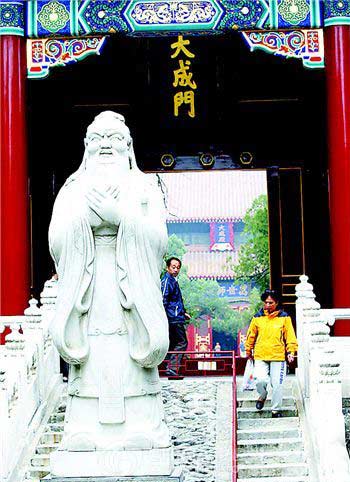
The Temple of Confucius, the present site of the Capital Museum, is located in Guozijian Street inside the north second ring road. This temple is situated hundreds meters west of Lama Temple. It is here that Confucius was worshipped during the Yuan, Ming and Qing dynasties (1271-1911). Now the temple houses the Beijing Capital Museum.
 The Temple of Confucius was initially built in 1302 and additions were made during the Ming and Qing dynasties. It has a total area of 22,000 square meters (5.4 acres). It is the second largest temple constructed for Confucius, the greatest thinker and educationalist in ancient China, ranking only behind the Temple of Confucius in Qufu, Shandong Province. This temple consists of four courtyards. The main structures include the Gate of the First Teacher, Gate of Great Accomplishment, Hall of Great Accomplishment and Worship Hall. Hall of Great Accomplishment is the main building in the temple, where the memorial ceremony for Confucius was often held. The eastern part of the front courtyard is taken up by the Pavilions for Stone Tablets, the Holy Kitchen, the Pavilion for Sacrificial Animals and the Well Pavilion; in the west, there are more pavilions for Stone Tablets, the hall of Vegetarian Diet and the Gate of Reverence which opens onto Imperial Academy. On either side of the courtyard, are arranged 198 stone tablets bearing 51,624 names of Advanced Scholars of the Yuan, Ming and Qing dynasties who passed the triennial imperial examinations. Inside the Gate of Great Accomplishment are placed ten stone drums which were made on ancient models 1736 to 1795 of the Qing Dynasty and erected two tablets associated with the event.
The Temple of Confucius was initially built in 1302 and additions were made during the Ming and Qing dynasties. It has a total area of 22,000 square meters (5.4 acres). It is the second largest temple constructed for Confucius, the greatest thinker and educationalist in ancient China, ranking only behind the Temple of Confucius in Qufu, Shandong Province. This temple consists of four courtyards. The main structures include the Gate of the First Teacher, Gate of Great Accomplishment, Hall of Great Accomplishment and Worship Hall. Hall of Great Accomplishment is the main building in the temple, where the memorial ceremony for Confucius was often held. The eastern part of the front courtyard is taken up by the Pavilions for Stone Tablets, the Holy Kitchen, the Pavilion for Sacrificial Animals and the Well Pavilion; in the west, there are more pavilions for Stone Tablets, the hall of Vegetarian Diet and the Gate of Reverence which opens onto Imperial Academy. On either side of the courtyard, are arranged 198 stone tablets bearing 51,624 names of Advanced Scholars of the Yuan, Ming and Qing dynasties who passed the triennial imperial examinations. Inside the Gate of Great Accomplishment are placed ten stone drums which were made on ancient models 1736 to 1795 of the Qing Dynasty and erected two tablets associated with the event.
One item of note is the 700-year-old Chujian Bai (Touch Evil Cypress) in the temple. Its name is associated with an ancient legend. During the Ming Dynasty, one day the superior official-Yan Song came to worship Confucius on behalf of the emperor. When he was passing by the cypress, one of the branches of the tree took his hat off. Since Yan Song was a treacherous official, people have thought the old tree could distinguish between good and evil people, hence its name.
In the temple, you can also find remarkable pictures like two flying dragons playing a pearl among clouds, which are believed to be used only in the imperial palaces because dragon stands for emperor in ancient China. From those, it is easy to imagine the importance of the Confucius Temple in the feudal society of China.

